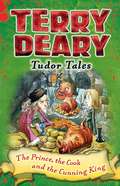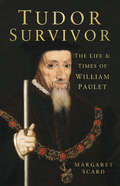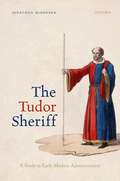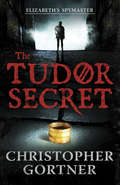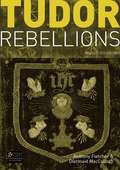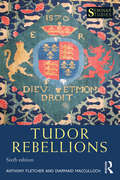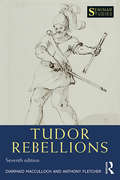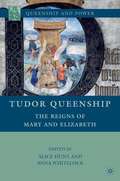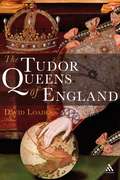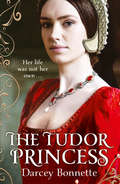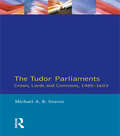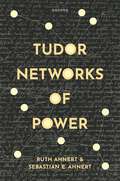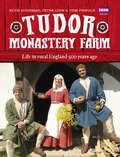- Table View
- List View
Tudor Tales: The Prince, the Cook and the Cunning King (Tudor Tales)
by Terry Deary Helen FlookFrom the bestselling author of Horrible Histories...King Henry VII is a mean and ruthless king and when a young boy named Lambert Simnel lays claim to the throne, Henry is furious. Lambert is no match for the powerful king – can he escape the extraordinary punishment he faces? Terry Deary's Tudor Tales explore the infamous world of the Tudors through the eyes of children who could have lived at the time. These stories feature real people and take place in some of the most recognisable Tudor settings. This new edition features notes for the reader to help extend learning and exploration of the historical period.
Tudor Survivor: The Life and Times of Courtier William Paulet (History Press Ser.)
by Margaret ScardWilliam Paulet was the ultimate courtier. For an astonishing 46 years he served at the courts of Henry VIII, Edward VI, Mary and Elizabeth and was one of the men responsbile for introducing the changes in religious, economic and social issues which shaped England as we know it today. He was a judge at the trials of Fisher, More and the alleged accomplices of Anne Boleyn, and though born a commoner, by his death he was the senior peer in England and, as Lord High Treasurer, he held one of the most influential positions at court. With his long and varied career within the royal household and in government, a study of Paulet presents an excellent opportunity to look in more detail at courtly life, allowing the reader an understanding of how he spent his working day. Tudor Survivor is the biography of the man who defined the role of courtier, but also gives valuable insight into everyday life, from etiquette and bathing, to court politics and the monarchs themselves. When asked how he had managed to survive so long, Paulet replied 'By being a willow, not an oak.'
Tudor Ship (1500AD) (UEB Uncontracted) (PDF)
by RnibThis image is of a large, three-masted wooden ship with its bow (front) at the right of the page, and its stern at the left. There is a locator dot shown, which will be at the top left of the page when the image is the right way up. The deep hull fills the lower part of the page. Mainly below the water at the left of the page is the rudder. Up from this is the sterncastle which can be seen above the hull at the stern of the ship. It is a wooden structure containing cabins on several floors. Sticking up from the sterncastle is the mizzen mast, which has a lookout basket (crow's nest) towards the top. The triangular mizzen sail is attached to this mast via a wooden beam along its right edge, and to the sterncastle by ropes. To the right of the sterncastle, the large rectangular mainsail - again with a crow's nest above it - is attached to the hull via the thick main mast and some ropes.To the right of the mainsail, at the bow of the ship, a squarish foresail is attached by the fore mast and ropes to the forecastle, which is a similar structure to the sterncastle. There is a third crow's nest towards the top of the fore mast, and a flag with tails flying forward at the very top. Just to the right of the forecastle, a short beam, the bowsprit, leans out almost horizontally.
Tudor Ship (1500AD) (UEB Contracted) (PDF)
by RnibThis image is of a large, three-masted wooden ship with its bow (front) at the right of the page, and its stern at the left. There is a locator dot shown, which will be at the top left of the page when the image is the right way up. The deep hull fills the lower part of the page. Mainly below the water at the left of the page is the rudder. Up from this is the sterncastle which can be seen above the hull at the stern of the ship. It is a wooden structure containing cabins on several floors. Sticking up from the sterncastle is the mizzen mast, which has a lookout basket (crow's nest) towards the top. The triangular mizzen sail is attached to this mast via a wooden beam along its right edge, and to the sterncastle by ropes. To the right of the sterncastle, the large rectangular mainsail - again with a crow's nest above it - is attached to the hull via the thick main mast and some ropes.To the right of the mainsail, at the bow of the ship, a squarish foresail is attached by the fore mast and ropes to the forecastle, which is a similar structure to the sterncastle. There is a third crow's nest towards the top of the fore mast, and a flag with tails flying forward at the very top. Just to the right of the forecastle, a short beam, the bowsprit, leans out almost horizontally.
Tudor Ship (1500AD) (Large Print) (PDF)
by RnibThis image is of a large, three-masted wooden ship with its bow (front) at the right of the page, and its stern at the left. There is a locator dot shown, which will be at the top left of the page when the image is the right way up. The deep hull fills the lower part of the page. Mainly below the water at the left of the page is the rudder. Up from this is the sterncastle which can be seen above the hull at the stern of the ship. It is a wooden structure containing cabins on several floors. Sticking up from the sterncastle is the mizzen mast, which has a lookout basket (crow's nest) towards the top. The triangular mizzen sail is attached to this mast via a wooden beam along its right edge, and to the sterncastle by ropes. To the right of the sterncastle, the large rectangular mainsail - again with a crow's nest above it - is attached to the hull via the thick main mast and some ropes.To the right of the mainsail, at the bow of the ship, a squarish foresail is attached by the fore mast and ropes to the forecastle, which is a similar structure to the sterncastle. There is a third crow's nest towards the top of the fore mast, and a flag with tails flying forward at the very top. Just to the right of the forecastle, a short beam, the bowsprit, leans out almost horizontally.
The Tudor Sheriff: A Study in Early Modern Administration
by Jonathan McGovernSheriffs were among the most important local office-holders in early modern England. They were generalist officers of the king responsible for executing legal process, holding local courts, empanelling juries, making arrests, executing criminals, collecting royal revenue, holding parliamentary elections, and many other vital duties. Although sheriffs have a cameo role in virtually every book about early modern England, the precise nature of their work has remained something of a mystery. The Tudor Sheriff offers the first comprehensive analysis of the shrieval system between 1485 and 1603. It demonstrates that this system was not abandoned to decay in the Tudor period, but was effectively reformed to ensure its continued relevance. Jonathan McGovern shows that sheriffs were not in competition with other branches of local government, such as the Lords Lieutenant and justices of the peace, but rather cooperated effectively with them. Since the office of sheriff was closely related to every other branch of government, a study of the sheriff is also a study of English government at work.
The Tudor Sheriff: A Study in Early Modern Administration
by Jonathan McGovernSheriffs were among the most important local office-holders in early modern England. They were generalist officers of the king responsible for executing legal process, holding local courts, empanelling juries, making arrests, executing criminals, collecting royal revenue, holding parliamentary elections, and many other vital duties. Although sheriffs have a cameo role in virtually every book about early modern England, the precise nature of their work has remained something of a mystery. The Tudor Sheriff offers the first comprehensive analysis of the shrieval system between 1485 and 1603. It demonstrates that this system was not abandoned to decay in the Tudor period, but was effectively reformed to ensure its continued relevance. Jonathan McGovern shows that sheriffs were not in competition with other branches of local government, such as the Lords Lieutenant and justices of the peace, but rather cooperated effectively with them. Since the office of sheriff was closely related to every other branch of government, a study of the sheriff is also a study of English government at work.
The Tudor Secret (The\elizabeth I Spymaster Chronicles #Bk. 1)
by Christopher GortnerSummer 1553: A time of danger and deceit. Brendan Prescott, an orphan, is reared in the household of the powerful Dudley family. Brought to court, Brendan finds himself sent on an illicit mission to the King’s brilliant but enigmatic sister, Princess Elizabeth. But Brendan is soon compelled to work as a double agent by Elizabeth’s protector, William Cecil—who promises in exchange to help him unravel the secret of his own mysterious past. A dark plot swirls around Elizabeth's quest to unravel the truth about the ominous disappearance of her seriously ill brother, King Edward VI. With only a stable boy and Elizabeth's lady-in-waiting at his side, Brendan plunges into a ruthless gambit of half-truths, lies, and murder. Filled with the intrigue and pageantry of Tudor England, THE TUDOR SECRET is the first book in the Elizabeth's Spymaster series.
Tudor Rose (tactile)
by Adrian FarnsworthThis page shows a tactile image of the Tudor Rose, the badge of the Tudor royal family.
Tudor Rebellions (PDF)
by Anthony FletcherThe Tudor age was a tumultuous one a time of the Reformation, conspiracies, uprisings and rebellions. The Tudor Rebellions gives a chronological run-down of the major rebellions and throws light on some of the main themes of Tudor history, including the dynasty s attempt to bring the north and west under the control of the capital, the progress of the English Reformation and the impact of inflation, taxation and enclosure on society. Successive versions of Tudor Rebellions have been central to understanding Tudor politics since 1968, when Anthony Fletcher first published his book. Now nearly four decades later, Professor Diarmaid MacCulloch has once more thoroughly revised and expanded this classic text to take into account exciting and innovative work on the subject in recent years.
Tudor Rebellions
by Anthony Fletcher Diarmaid MacCullochTudor Rebellions, now in its sixth edition, gives a chronological account of the major rebellions against the Tudor monarchy from the reign of King Henry VII until the death of Queen Elizabeth I in 1603. It also throws light on some of the main themes of Tudor history, including the dynasty’s attempt to bring the north and west under the control of the capital, the progress of the English Reformation and the impact of inflation, taxation and enclosure on society. This new edition has been thoroughly revised to take into account the exciting and innovative work on the subject in recent years and bring the historiographical debates right up to date. It now includes additional documents and extended discussions to bring to life the complex events and politics of the rebellions. The primary sources, alongside a narrative history, allow students to fully explore these turbulent times, seeking to understand what drove Tudor people to rebel and what sort of people were inclined to do so. In doing so, the book considers both ‘high’ and ‘low’ politics, and the concerns of both the noble and the unprivileged in Tudor society. With supplementary materials including a chronology, who’s who and guide to further reading along with maps and images, Tudor Rebellions is an invaluable resource for all students of Tudor history.
Tudor Rebellions
by Anthony Fletcher Diarmaid MacCullochTudor Rebellions, now in its sixth edition, gives a chronological account of the major rebellions against the Tudor monarchy from the reign of King Henry VII until the death of Queen Elizabeth I in 1603. It also throws light on some of the main themes of Tudor history, including the dynasty’s attempt to bring the north and west under the control of the capital, the progress of the English Reformation and the impact of inflation, taxation and enclosure on society. This new edition has been thoroughly revised to take into account the exciting and innovative work on the subject in recent years and bring the historiographical debates right up to date. It now includes additional documents and extended discussions to bring to life the complex events and politics of the rebellions. The primary sources, alongside a narrative history, allow students to fully explore these turbulent times, seeking to understand what drove Tudor people to rebel and what sort of people were inclined to do so. In doing so, the book considers both ‘high’ and ‘low’ politics, and the concerns of both the noble and the unprivileged in Tudor society. With supplementary materials including a chronology, who’s who and guide to further reading along with maps and images, Tudor Rebellions is an invaluable resource for all students of Tudor history.
Tudor Rebellions (Seminar Studies)
by Diarmaid MacCulloch Anthony FletcherTudor Rebellions, now in its seventh edition, gives a chronological account of the major rebellions against the Tudor monarchy in England from the reign of King Henry VII until the death of Queen Elizabeth I in 1603. The book throws light on some of the main themes of Tudor history, including the dynasty’s attempt to bring the north and west under the control of the capital, the progress of the English Reformation and the impact of inflation, taxation and enclosure on society, and makes comparisons with the other Tudor realm of Ireland. This new edition has been revised once more to take into account the exciting and innovative work on the subject in recent years and bring the historiographical debates right up to date. The primary sources, alongside the narrative history, allow students to fully explore these turbulent times, seeking to understand what drove Tudor people to rebel and what sort of people were inclined to do so. In doing so, the book considers both ‘high’ and ‘low’ politics, and the concerns of both the noble and the unprivileged in Tudor society. With supplementary materials including a chronology, who’s who and guide to further reading along with a selection of maps and images, Tudor Rebellions is an invaluable resource for all students of Tudor history.
Tudor Rebellions (Seminar Studies)
by Diarmaid MacCulloch Anthony FletcherTudor Rebellions, now in its seventh edition, gives a chronological account of the major rebellions against the Tudor monarchy in England from the reign of King Henry VII until the death of Queen Elizabeth I in 1603. The book throws light on some of the main themes of Tudor history, including the dynasty’s attempt to bring the north and west under the control of the capital, the progress of the English Reformation and the impact of inflation, taxation and enclosure on society, and makes comparisons with the other Tudor realm of Ireland. This new edition has been revised once more to take into account the exciting and innovative work on the subject in recent years and bring the historiographical debates right up to date. The primary sources, alongside the narrative history, allow students to fully explore these turbulent times, seeking to understand what drove Tudor people to rebel and what sort of people were inclined to do so. In doing so, the book considers both ‘high’ and ‘low’ politics, and the concerns of both the noble and the unprivileged in Tudor society. With supplementary materials including a chronology, who’s who and guide to further reading along with a selection of maps and images, Tudor Rebellions is an invaluable resource for all students of Tudor history.
Tudor Queenship: The Reigns of Mary and Elizabeth (Queenship and Power)
by Alice Hunt & Anna WhitelockThis book brings together a selection of recent, cutting-edge research which, for the first time, challenges commonplace arguments about Mary and Elizabeth's relative successes or failures in order to rethink Tudor queenship.
The Tudor Queens of England
by David LoadesAn intimate and revealing look at the daily lives and responsibilities of the Tudor Queens of England From Elizabeth of York, wife of Henry VII, the first Tudor monarch, to Elizabeth I, her grand-daughter and the last, The Tudor Queens of England delves into the secret lives of some of the most colorful and dramatic women in British history. The majority of the fourteen queens considered here, from Catherine de Valois and Elizabeth Woodville to Elizabeth of York, Jane Seymour and Catherine Parr, were consorts, the wives of kings. Although less frequently examined than ruling queens, queen consorts played a crucial and central role within the Royal Court. Their first duty was to bear children and their chastity within marriage had to be above reproach. Any suspicion of sexual misconduct would cast doubt on the legitimacy of their offspring. Three of these women - Margaret of Anjou, Anne Boleyn and Catherine Howard - were accused of such conduct, and two were tried and executed. A queen also had to contribute to her husband's royal image. This could be through works of piety or through humble intercession. It could also be through her fecundity because the fathering of many children was a sign of virility and of divine blessing. A queen might also make a tangible contribution to her husband's power with her marriage as the symbol of an international diplomatic agreement. A ruling queen was very different, especially if she was married, insofar as she had to fill the roles of both king and queen. No woman could be both martial and virile, and at the same time submissive and supportive. Mary I solved this problem in a constitutional sense but never at the personal level. Elizabeth I sacrificed motherhood by not marrying. She chose to be mysterious and unattainable - la belle dame sans merci. In later life she used her virginity to symbolize the integrity of her realm and her subjects remained fascinated by her unorthodoxy. How did they behave (in and out of the bedchamber)? How powerful were they as patrons of learning and the arts? What religious views did they espouse and why? How successful and influential were they? From convenient accessory to sovereign lady the role of queen was critical, colorful, and often dramatic. The Tudor Queens of England is the first book of its kind to intimately examine these questions and more.
The Tudor Princess
by Darcey BonnetteLove, treachery and betrayal at court… The perfect read for fans of Philippa Gregory and Susannah Dunn.
Tudor peasants (UEB Uncontracted)
by Rnib BookshareThis image is of a large, three-masted wooden ship with its bow (front) at the right of the page, and its stern at the left. There is a locator dot shown, which will be at the top left of the page when the image is the right way up. The deep hull fills the lower part of the page. Mainly below the water at the left of the page is the rudder. Up from this is the sterncastle which can be seen above the hull at the stern of the ship. It is a wooden structure containing cabins on several floors. Sticking up from the sterncastle is the mizzen mast, which has a lookout basket (crow's nest) towards the top. The triangular mizzen sail is attached to this mast via a wooden beam along its right edge, and to the sterncastle by ropes. To the right of the sterncastle, the large rectangular mainsail - again with a crow's nest above it - is attached to the hull via the thick main mast and some ropes.To the right of the mainsail, at the bow of the ship, a squarish foresail is attached by the fore mast and ropes to the forecastle, which is a similar structure to the sterncastle. There is a third crow's nest towards the top of the fore mast, and a flag with tails flying forward at the very top. Just to the right of the forecastle, a short beam, the bowsprit, leans out almost horizontally.
Tudor peasants (UEB Contracted)
by Rnib BookshareThis image is of a large, three-masted wooden ship with its bow (front) at the right of the page, and its stern at the left. There is a locator dot shown, which will be at the top left of the page when the image is the right way up. The deep hull fills the lower part of the page. Mainly below the water at the left of the page is the rudder. Up from this is the sterncastle which can be seen above the hull at the stern of the ship. It is a wooden structure containing cabins on several floors. Sticking up from the sterncastle is the mizzen mast, which has a lookout basket (crow's nest) towards the top. The triangular mizzen sail is attached to this mast via a wooden beam along its right edge, and to the sterncastle by ropes. To the right of the sterncastle, the large rectangular mainsail - again with a crow's nest above it - is attached to the hull via the thick main mast and some ropes.To the right of the mainsail, at the bow of the ship, a squarish foresail is attached by the fore mast and ropes to the forecastle, which is a similar structure to the sterncastle. There is a third crow's nest towards the top of the fore mast, and a flag with tails flying forward at the very top. Just to the right of the forecastle, a short beam, the bowsprit, leans out almost horizontally.
Tudor peasants (Large Print)
by Rnib BookshareThis image is of a large, three-masted wooden ship with its bow (front) at the right of the page, and its stern at the left. There is a locator dot shown, which will be at the top left of the page when the image is the right way up. The deep hull fills the lower part of the page. Mainly below the water at the left of the page is the rudder. Up from this is the sterncastle which can be seen above the hull at the stern of the ship. It is a wooden structure containing cabins on several floors. Sticking up from the sterncastle is the mizzen mast, which has a lookout basket (crow's nest) towards the top. The triangular mizzen sail is attached to this mast via a wooden beam along its right edge, and to the sterncastle by ropes. To the right of the sterncastle, the large rectangular mainsail - again with a crow's nest above it - is attached to the hull via the thick main mast and some ropes.To the right of the mainsail, at the bow of the ship, a squarish foresail is attached by the fore mast and ropes to the forecastle, which is a similar structure to the sterncastle. There is a third crow's nest towards the top of the fore mast, and a flag with tails flying forward at the very top. Just to the right of the forecastle, a short beam, the bowsprit, leans out almost horizontally.
Tudor Parliaments,The Crown,Lords and Commons,1485-1603
by Michael A.R. GravesThis excellent short survey looks at the workings of parliament under the first four Tudor monarchs. After an introductory first section which looks at parliament's medieval origins, the author then considers all aspects of early parliamentary history - including the historiography of the early Tudor parliaments, membership and attendance, the legislative roles of the Lords and Commons and the specific parliaments themselves.
Tudor Parliaments,The Crown,Lords and Commons,1485-1603
by Michael A.R. GravesThis excellent short survey looks at the workings of parliament under the first four Tudor monarchs. After an introductory first section which looks at parliament's medieval origins, the author then considers all aspects of early parliamentary history - including the historiography of the early Tudor parliaments, membership and attendance, the legislative roles of the Lords and Commons and the specific parliaments themselves.
Tudor Networks of Power
by Prof Ruth Ahnert Dr Sebastian E. AhnertTudor Networks of Power is the product of a groundbreaking collaboration between an early modern book historian and a physicist specializing in complex networks. Together they have reconstructed and computationally analysed the networks of intelligence, diplomacy, and political influence across a century of Tudor history (1509-1603), based on the British State Papers. The 130,000 letters that survive in the State Papers from the Tudor period provide crucial information about the textual organization of the social network centred on the Tudor government. Whole libraries have been written using this archive, but until now nobody has had access to the macroscopic tools that allow us to ask questions such as: What are the reasons for the structure of the Tudor government's intelligence network? What was it geographical reach and coverage? Can we use network data to show patterns of surveillance? What role did women play in these government networks? And what biases are there in the data? The authors employ methods from the field of network science, translating key concepts and approaches into a language accessible to literary scholars and historians, and illustrating them with examples drawn from this fantastically rich archive. Each chapter is the product of a set of thematically organized 'experiments', which show how particular methods can help to ask and answer research questions specific to the State Papers archive, but also have applications for other large bodies of humanities data. The fundamental aim of this book, therefore, is not merely to provide an innovative perspective on Tudor politics; it also aspires to introduce an entirely new audience to the methods and applications of network science, and to suggest the suitability of these methods for a range of humanistic inquiry.
Tudor Networks of Power
by Prof Ruth Ahnert Dr Sebastian E. AhnertTudor Networks of Power is the product of a groundbreaking collaboration between an early modern book historian and a physicist specializing in complex networks. Together they have reconstructed and computationally analysed the networks of intelligence, diplomacy, and political influence across a century of Tudor history (1509-1603), based on the British State Papers. The 130,000 letters that survive in the State Papers from the Tudor period provide crucial information about the textual organization of the social network centred on the Tudor government. Whole libraries have been written using this archive, but until now nobody has had access to the macroscopic tools that allow us to ask questions such as: What are the reasons for the structure of the Tudor government's intelligence network? What was it geographical reach and coverage? Can we use network data to show patterns of surveillance? What role did women play in these government networks? And what biases are there in the data? The authors employ methods from the field of network science, translating key concepts and approaches into a language accessible to literary scholars and historians, and illustrating them with examples drawn from this fantastically rich archive. Each chapter is the product of a set of thematically organized 'experiments', which show how particular methods can help to ask and answer research questions specific to the State Papers archive, but also have applications for other large bodies of humanities data. The fundamental aim of this book, therefore, is not merely to provide an innovative perspective on Tudor politics; it also aspires to introduce an entirely new audience to the methods and applications of network science, and to suggest the suitability of these methods for a range of humanistic inquiry.
Tudor Monastery Farm: Life in rural England 500 years ago
by Peter Ginn Ruth GoodmanRuth Goodman and Peter Ginn have become familiar faces on BBC2 after their hugely popular and immersive time-travelling experiments, Victorian, Edwardian and Wartime Farm. But for their fourth series, and our accompanying book, they have joined forces with Tom Pinfold to take on their biggest challenge yet: going back to Tudor England to endure the harsh realities of working for an Abbey Farm.Peter, Ruth and Tom are trained historians, driven by new research and discovery. They are passionate about bringing period details to life, and they do that for us by comprehensively inhabiting the era for months, using only materials, tools and technology available at the time, to earn their living, celebrate their holidays, clothe and feed themselves and their families. Follow them as they discover how to build a pigsty, brew their own ale, forge their own machinery and keep a Tudor household. Scrupulously researched, totally authentic and with its own contemporary narrative playing out within an accurate reconstruction of Tudor England, this is a fantastic glimpse into history, as it was lived. This is set to be Peter, Ruth and Tom’s most ambitious historical assignment yet.
